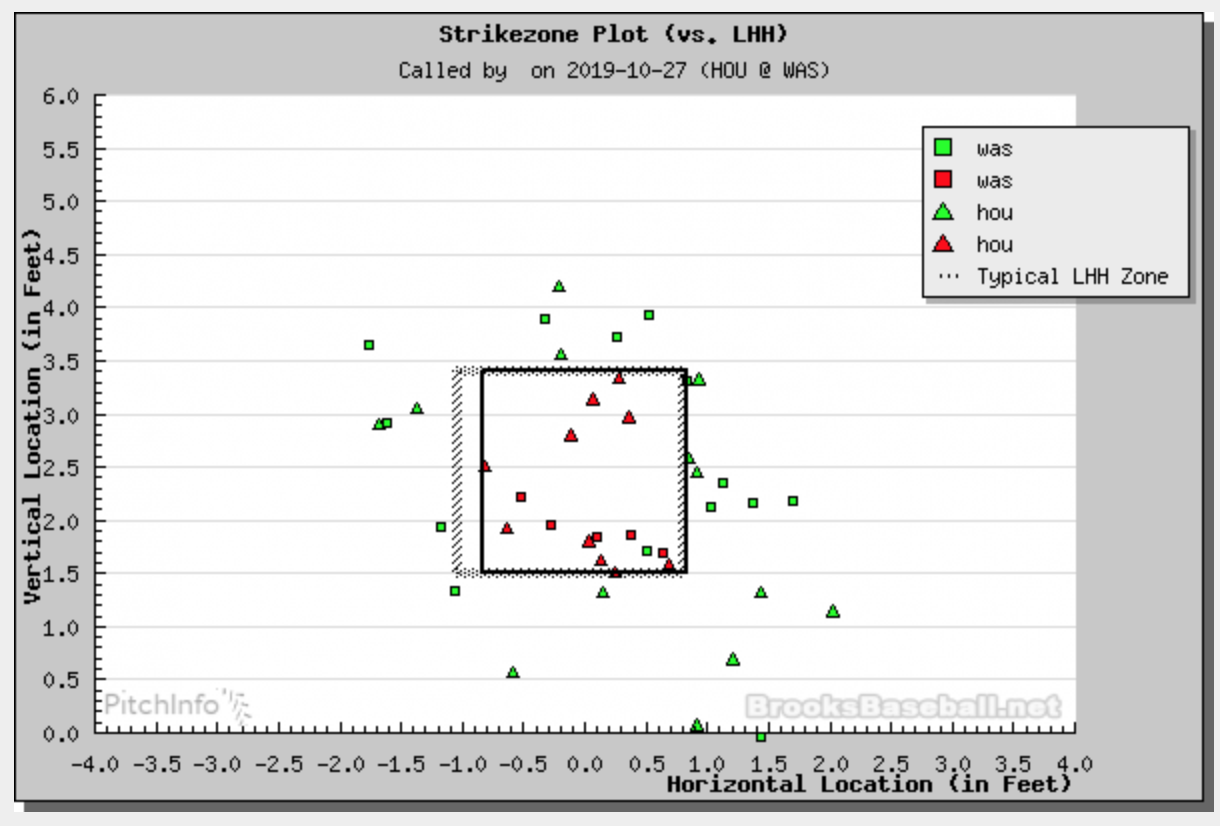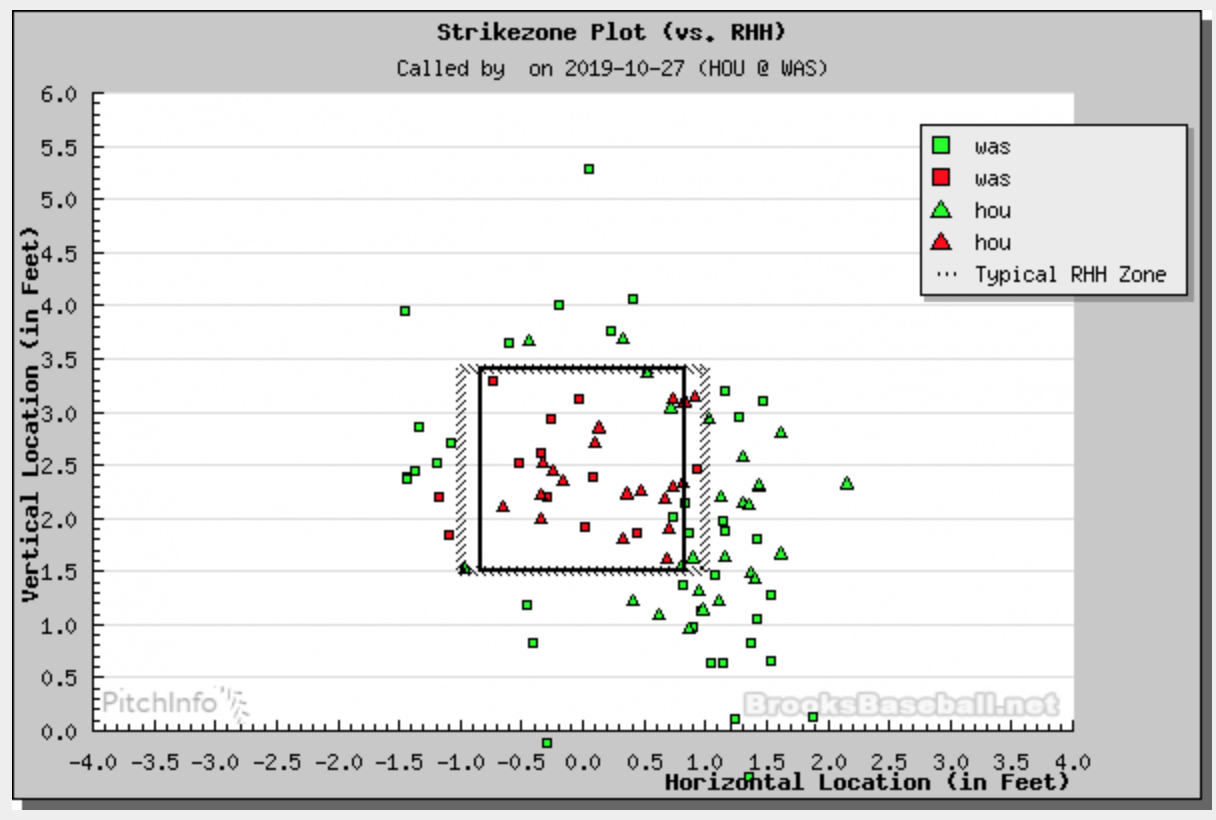A World Series has been tied at two games apiece 45 times in MLB history. And on 30 of those occasions, the winner of Game 5 has gone on to claim the championship.
The Houston Astros will now attempt to make it 31.
After falling behind 2-0 in the series, the Astros have rattled off three consecutive wins on the road against the Washington Nationals — including Sunday’s 7-1 victory — and will head home to Texas with two opportunities to win a second title in three seasons. Here’s what happened in Game 5.
Big-game Gerrit
What else is there to say about Gerrit Cole? He’s been the pitcher of the post-season. He was the pitcher of the regular season, too. And he’s about to be the pitcher of the off-season as he hits free agency at the absolute perfect moment.
Cole was dominant again Sunday, allowing a run on three hits and two walks over seven innings, striking out nine. He went seven innings or more in all five of his starts this post-season, pitching to a 1.72 ERA with 11.5 K/9. That after leading the American League with a 2.50 ERA, 13.8 K/9, and 7.4 wins above replacement. Between the regular season and playoffs, Cole struck out 373 over 249 innings.
The Pitching Ninja Twitter account was originated for nights Cole pitches and here’s a particularly unfair sequence to Ryan Zimmerman who didn’t have to deal with nastiness like this when he was facing literal hall-of-famers like Tom Glavine and John Smoltz as a rookie:
Gerrit Cole, Double Sword K (98mph Fastball and 87mph Knuckle Curve). pic.twitter.com/M4tRn0EiiI
— Rob Friedman (@PitchingNinja) October 28, 2019
Cole’s only blemish was a Juan Soto solo shot in the seventh, which is forgivable, because Soto’s electric. Otherwise, he made mincemeat of Washington hitters with a fastball that sat 97-m.p.h. and touched triple-digits, a slider that sat 90-m.p.h., and a mid-80’s curveball he both flipped into the zone for strikes and buried in the dirt for swing-and-miss.
He’s just a stud, and whichever team invests heavily in him with a big free agent contract this winter isn’t likely to regret it. Will Cole be this dominant at 34 or 35 when he’d be in Year 5 or 6 of a potential deal? Probably not. But when you sign a big-ticket free agent like Cole, you bake that performance decline in.
You’re front-loading the team value of the contract to get maximum impact in the early years of the deal. And whichever team makes that deal with Cole will be dramatically improving their chances of winning in the near term. Which is what every team in the game ought to be doing.
Scherzer scratched
The Nationals were dealt a severe blow before the game even began when Max Scherzer was scratched due to neck and back spasms. Considering the gravity of Sunday’s game, Scherzer’s well-established and occasionally alarming competitiveness, and the fact the three-time Cy Young winner pitched seven scoreless innings with a broken nose earlier this season, that had to be some pretty bad pain.
The guy who had to fill in for one of the game’s most dominant pitchers? Joe Ross — a swingman who pitched to a 5.48 ERA over 64 regular-season innings and entered the night having made only two appearances this October in low-leverage situations, which really tells you all you need to know about how much trust Nationals manager Dave Martinez has in him.
But it was desperate times. Martinez’s bullpen logged heavy workloads in Games 3 and 4 of the series, leaving the little-used Ross as Washington’s freshest option to throw multiple innings. Would he seize this unexpected opportunity and thrive, authoring a remarkable page in the World Series history books?
The answer was no. Yordan Alvarez took Ross 405 feet to left-centre for a two-run shot in the second, and Carlos Correa obliterated a pitch 396 feet into the left-field seats for another two- run shot in the fourth. But that was the only damage Ross allowed, as he found a way to work around a couple walks and some very hard Astros contact — Houston batters put eight balls in play at 99-m.p.h. or higher against Ross — to keep things on the rails for five innings.
Considering the circumstances, a four-run, five-and-dive outing from Ross isn’t a terrible outcome at all. With how good Cole is and was, Ross would’ve had to be close to perfect in order to keep pace. But things could have gone a whole heck of a lot worse and when Ross left the game the Nationals were at least within striking distance. Not bad in a tough spot.
Offence over defence
Even since the series shifted to Washington, removing the designated hitter from each team under National League rules, Astros manager A.J. Hinch has been forced to go without Yordan Alvarez’s big bat in his lineup.
The 22-year-old Cuban is a prodigious offensive talent — despite slumping significantly earlier in the post-season — who will likely win the AL rookie-of-the-year award, but he’s not much of a defender. Plus, the Astros are stacked and still field an imposing lineup even without a guy who put up a 1.067 OPS this season. So, Alvarez watched most of Games 3 and 4, appearing only as a late-inning pinch-hitter.
But ahead of Game 5, Hinch said he didn’t want to go three consecutive games without Alvarez making multiple plate appearances. So, he hid him in left field on a night that his high-strikeout ace was on the mound, betting the ball would be in play less often and hoping it wouldn’t find Alvarez in a bad way.
And here’s why Hinch made that decision:
That is a pretty decently located fastball with late life that Alvarez absolutely rocketed into the gut of a fan standing beyond the deepest outfield wall at Nationals Park.
Then, his next time up, Alvarez worked a seven-pitch plate appearance resulting in a single to right that came off his bat at 100-m.p.h. And in his third plate appearance, he led off the seventh with a 107-m.p.h. laser of a single off Sean Doolittle.
Could Alvarez have been exposed on a tough ball or two to left? Absolutely. But he could also come up with three hits, all of them with triple-digit exit velocities. Maximizing your ability to prevent runs is important. But if you score enough of them, it doesn’t matter.
Balls and strikes
Home plate umpire Lance Barksdale didn’t have his best night in this one, misjudging a handful of balls and strikes, including an 0-2 Ross slider to Correa with two out in the fourth that appeared to catch the outside corner for what would have been strike three. Instead, it was ruled ball one. Four pitches later, Correa took Ross deep.


And in the seventh, as the Nationals were finally getting to Cole and taking some extremely stubborn plate appearances, Barksdale called a full-count, two-out pitch to Victor Robles a strike, ending the inning.
Look, the job’s really tough. You’re making immediate judgments on the location of a rapidly and unpredictably moving small object within a variable, imaginary box while wearing a mask. To expect MLB umpires to get 100 per cent of their calls correct is absurd. It’s actually remarkable, in today’s era of higher velocities and nastier stuff, that they call the game with the accuracy that they do.
Still, technology exists that can improve this process. And it needs to be part of the MLB product before long. The league has already experimented with an electronically judged strike zone in the Atlantic League and Arizona Fall League this season. And it ought to be implemented across the minors before long, before it’s ultimately introduced at the MLB level.
Traditionalists won’t like it at first. That’s fine. Many didn’t like the designated hitter at first. But people get used to things awfully quickly. An electronic strike zone will be the same. There’s too much on the line to not be getting the calls right.
from Sports - Latest - Google News https://ift.tt/2pmpzBY
via IFTTT
October 28, 2019 at 10:59AM
Tidak ada komentar:
Posting Komentar